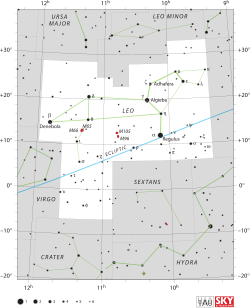Theta Leonis
| Observation data Epoch J2000.0 Equinox J2000.0 |
|
|---|---|
| Constellation | Leo |
| Right ascension | 11h 14m 14.40446s |
| Declination | +15° 25′ 46.4541″ |
| Apparent magnitude (V) | +3.324 |
| Characteristics | |
| Spectral type | A2 V |
| U−B color index | +0.07 |
| B−V color index | –0.02 |
| Astrometry | |
| Radial velocity (Rv) | +7.6 km/s |
| Proper motion (μ) |
RA: -60.31 mas/yr Dec.: -79.10 mas/yr |
| Parallax (π) | 19.76 ± 0.17mas |
| Distance | 165 ± 1 ly (50.6 ± 0.4 pc) |
| Details | |
| Mass | 2.5 M☉ |
| Luminosity | 141 L☉ |
| Surface gravity (log g) | 3.65 cgs |
| Temperature | 9,350 K |
| Metallicity [Fe/H] | +0.05 dex |
| Rotational velocity (v sin i) | 23 km/s |
| Age | 550 Myr |
| Other designations | |
| Database references | |
| SIMBAD | data |
Theta Leonis (θ Leonis, abbreviated Theta Leo, θ Leo), also named Chertan, is a star in the constellation of Leo. With an apparent visual magnitude of +3.324 it is visible to the naked eye and forms one of the brighter stars in the constellation. The distance from the Sun can be directly determined from parallax measurements, yielding a value of about 165 light-years (51 parsecs).
This is a large star with 2.5 times the mass of the Sun. The spectrum matches a stellar classification of A2 V, making this a seemingly typical A-type main sequence star. However, the spectrum shows enhanced absorption lines of metals, marking this as a chemically peculiar Am star. The abundance of elements other than hydrogen and helium, what astronomers term the star's metallicity, appears around 12% higher than in the Sun. It is radiating 141 times the luminosity of the Sun from its outer atmosphere at an effective temperature of 9,350 K, literally giving it a white-hot glow.
Theta Leonis is much younger than the Sun, with an estimated age of around 550 million years. It has a moderately high rate of rotation, with a projected rotational velocity of 23 km s−1. Measurements in the infrared band show an excess of emission from the star and its surroundings, suggesting the presence of a circumstellar disk of dust. The temperature of this emission indicates the disk has an orbital radius of 36 AU.
...
Wikipedia

